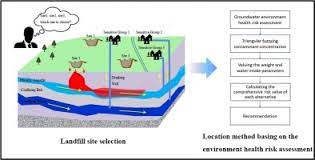Courtesy : www.mpcb.gov.in/
Environment assessment and site selesction
1.0 INTRODUCTION
The rapid growth of industries has entirely changed the hazardous waste generation scenario in the country.
The quantity of hazardous wastes generated has increased appreciably and the nature of the waste generated
has become complex. In order to manage these waste scientifically, Ministry of Environment and Forest has
promulgated Hazardous Waste (Management & Handling) Rules, 1989 and amended them in year 2000.
According to the rules, hazardous wastes have to be managed scientifically. Environmentally sound
management of hazardous wastes would require Common Hazardous Waste Management Facility (CHWMF)
for industrial clusters spread all over the country, as it is not possible to have hazardous waste management
facility for each unit. Such CHWMFs becomes more necessary in the wake of large number of SMEs in our
country, which neither have funds nor space for development of hazardous waste management facilities.
CHWMF would facilitate operations like waste pre-treatment, storage of various hazardous wastes, stabilization,
leachate treatment, incineration and final disposal. All these operations would release various pollutants into
the environment, which in turn may cause low to severe damages to the ecosystem, if not handled properly.
In view of this, it is very important to site such facilities in systematic way through evaluating the environmental
adequacy. Amended rules state that after preliminary impact assessment studies, for identification of possible
sites for disposal facility, EIA study should be undertaken to select appropriate site.
The objective of this approach paper is to provide the procedural guidelines for carrying out EIA for site
selection for development of Common Hazardous Waste Management Facility (CHWMF).
2.0 DEFINITION & NEED
Environmental Impact Assessment (EIA) is the process of identifying and evaluating the effects on the
environment of impact factors arising from a proposed change in environmental quality. In other words, we
can say that the purpose of an EIA is to determine the potential environmental, social and health effects of a
proposed development. It is a systematic examination of the environmental consequences of projects, policies,
plans and programs. Its main aim is to provide decision-makers with an account of the implications of alternative
courses of action before a decision is made.
During the process of EIA, various project alternatives are studied and potential adverse and beneficial
environmental impacts of the project activities are singled out. Based on this, the project alternative is selected
and mitigation measures are identified for the adverse impacts arising out of the activities of the project in
order to mitigate the adverse impacts on air, water, soil, flora and fauna. Thus through Environment Impact
Assessment studies, environment issues can be identified in advance and addressed at a fundamental level
eliminating delays in the planning process or during implementation due to unforseen environmental problems.
The negative decisions that may arise from the process are of greatest benefit in terms of pollution control
and environmental management.
3.0 OVERVIEW OF EIA FOR CHWMF
Overview Environmental Impact Assessment Projects for Development of Hazardous Waste Disposal
Facility – Overview.
General stages of Environment Impact Assessment are as depicted in following figure :
GUIDELINES FOR
CONDUCTING ENVIRONMENTAL IMPACT ASSESSMENT :
SITE SELECTION FOR COMMON HAZARDOUS WASTE
MANAGEMENT FACILITY
2
In broad terms, Environmental Impact Assessment Process for CHWMF undergoes four stages :
(i) Project Definition; Project definition includes basic designing of the project and identification of project
alternatives, screening and scoping of the project.
(ii) Preliminary Impact Assessment : Based on the project activities and project type, candidate sites
would be identified and subject to preliminary assessment keeping in view the present usage of site
and it’s surroundings and prominent features in order to single out potential sites for development of
CHWMF.
(iii) Environment Impact Assessment : All Potential sites would be subjected to detailed environmental
assessment which would consist of baseline data collection, prediction of environmental impacts
and their evaluation, identification of mitigation measures and finally preparation of Environmental
Impact Statement (EIS) and Environmental Management Plan (EMP).
(iv) Decision Making & Implementation : Based on the findings of EIA, final site would be recommended
with appropriate Environment Management Plan comprising of different technical measures to mitigate
the adverse environmental impacts. This site would be notified by the state government and
construction of CHWMF would be taken up.
All the stages are connected to each other in a cyclic form and the whole process is of iterative nature as
indicated in above figure. The two main components, which interlink with the main stages are: (i) consideration
of the need to mitigate the impacts by changes to the proposal and (ii) consultation, both informal and formal,
with interested parties. These two components provide a common thread throughout the process, allowing at
any time for the assessor to revise previous judgements, measurements and decisions.
4.0 Project Definition
The first step in Project Definition is defining the objective or purpose of the project. Once the purpose of the
project is understood, the various alternatives to achieve the objective have to be listed out. These alternatives
are then compared with respect to their techno-economic feasibility. This helps in screening of the best fitting
alternative. Once the alternative is decided, scoping of the project is to be finalised. Scoping helps in minimising
the potential for disputes over the adequacy of the Environmental assessment statements later in the
Environment assessment process.




